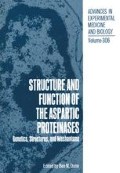Abstract
Porcine pepsin has long been recognized to have primary and secondary specificity for hydrophobic amino acids, and the binding of low molecular weight inhibitors (e.g., aliphatic alcohols) is also dominated by hydrophobic interactions1. However, the long standing ‘hydrophobic dogma’ in pepsin catalysis was seriously challenged when Pohl and Dunn2 described a series of polycationic oligopeptides that are among the most reactive synthetic substrates known. These highly hydrophilic molecules should not be well accommodated in a hydrophobic active site. Moreover, the steady state kinetic parameters were remarkably sensitive to the acidity of the medium. As the pH was increased from pH 3 to 6, the specificity number kcat/Km increased by three to four orders of magnitude and approached values close to the diffusion limit. The catalytic turnover number kcat was much less affected by the increase in pH, and the Michaelis constant Km decreased accordingly, by three to four orders of magnitude. A typical pH profile of steady state kinetic parameters, for the substrate Lys-Lys-Ala-Lys-Phe-Phe(NO2)-Arg-Leu, is shown in Figure 1.
Access this chapter
Tax calculation will be finalised at checkout
Purchases are for personal use only
Preview
Unable to display preview. Download preview PDF.
References
J. Fruton, Adv. Enzymol. Related Areas Mol. Biol. 44: 1–36 (1976).
J. Pohl and B. M. Dunn, Biochemistry 27: 4827–4834 (1988).
D. H. Rich and M. S. Bernatowicz, J. Med. Chem. 25: 791–795 (1982).
F. C. Salituro, N. Agarwal, T. Hofmann and D. H. Rich, J. Med. Chem. 30: 286–295 (1987).
Logarithmic partition coefficients logP for the sidechains (beginning with Cβ) were calculated from atomic contributions reported in (a) A. K. Ghose and G. M. Crippen, J. Comput. Chem. 7: 565–577 (1986); (b) P. Furet, A. Sele and N. C. Cohen, J. Mol Graphics 6:182-189 (1988); (c) D. Eisenberg and A. D. McLachlan, Nature (London) 319:199-203 (1986).
H. J. Nolte, T. L. Rosenberry and E. Neumann, Biochemistry 19: 3705–3711 (1980).
(a) E. Neumann, in “Topics of Bioelectrochemistry and Bioenergetics” (G. Milazzo, Ed.), John Wiley, New York, pp. 113–160 (1981). (b) E. Neumann, in “Structural and Functional Aspects of Enzyme Catalysis” (H. Eggerer, R. Huber, Eds.), Springer-Verlag, Berlin (1981). (c) E. Neumann, in “Modern Bioelectrochemistry” (F. Gutmann, K. Keyzer, Eds.), Plenum Press, New York, pp. 97-175 (1986). (d) E. Neumann, Prog. Biophys. Molec. Biol. 47:197-231 (1986). (e) N. K. Rogers, Progr. Biophys. Molec. Biol. 48:37-66 (1986).
B. M. Dunn, B. Parten, M. Jimenez, C. E. Rolph, M. Valler and J. Kay, in “Aspartic Proteinases and their Inhibitors” (V. Kostka, Ed.), Walter de Gruyter, Berlin, pp. 221–243 (1985).
W. W. Cleland, Biochemistry 14: 3220–3224 (1975).
D. A. Case, Prog. Biophys. Molec. Biol. 52: 39–70 (1988).
D. H. Rich and D. B. Northrop, in “Computer Aided Drug Design” (T. J. Perun and C. L. Probst, Eds.), Marcel Dekker, New York, p. 185–250 (1989).
M. Miller, J. Schneider, B. K. Sathyanarayna, M. V. Toth, G. R. Marshall, L. Clawson, L. Selk, S. B. H. Kent, and A. Wlodawer, Science (Washington, D.C.) 246: 1149–1152 (1989).
P. S. Vermesch, J. J. G. Tesmer, D. D. Lemon and F. A. Quiocho, J. Biol. Chem. 265: 16592–16603 (1990).
(a) P. Haberfield and J. J. Cincotta, J.Org.Chem. 55: 1334–1338 (1990). (b) A. J. Kirby, Adv.Phys.Org.Chem. 17:183 (1980).
(a) K. C. Chou and S. P. Jiang, Sci. Sin. 17: 664–680 (1974). (b) K. C. Chou, Sci. Sin. 19:505-528 (1976). (c) K. C. Chou and S. Forsén, Biophys. Chem. 12:255-263 (1980). (d) K. C. Chou and G. P. Zhou, J. Amer. Chem. Soc. 104:1409-1413 (1982).
Author information
Authors and Affiliations
Editor information
Editors and Affiliations
Rights and permissions
Copyright information
© 1991 Plenum Press, New York
About this chapter
Cite this chapter
Kuzmič, P., Sun, CQ., Zhao, ZC., Rich, D.H. (1991). Nonspecific Electrostatic Binding of Substrates and Inhibitors to Porcine Pepsin. In: Dunn, B.M. (eds) Structure and Function of the Aspartic Proteinases. Advances in Experimental Medicine and Biology, vol 306. Springer, Boston, MA. https://doi.org/10.1007/978-1-4684-6012-4_7
Download citation
DOI: https://doi.org/10.1007/978-1-4684-6012-4_7
Publisher Name: Springer, Boston, MA
Print ISBN: 978-1-4684-6014-8
Online ISBN: 978-1-4684-6012-4
eBook Packages: Springer Book Archive

